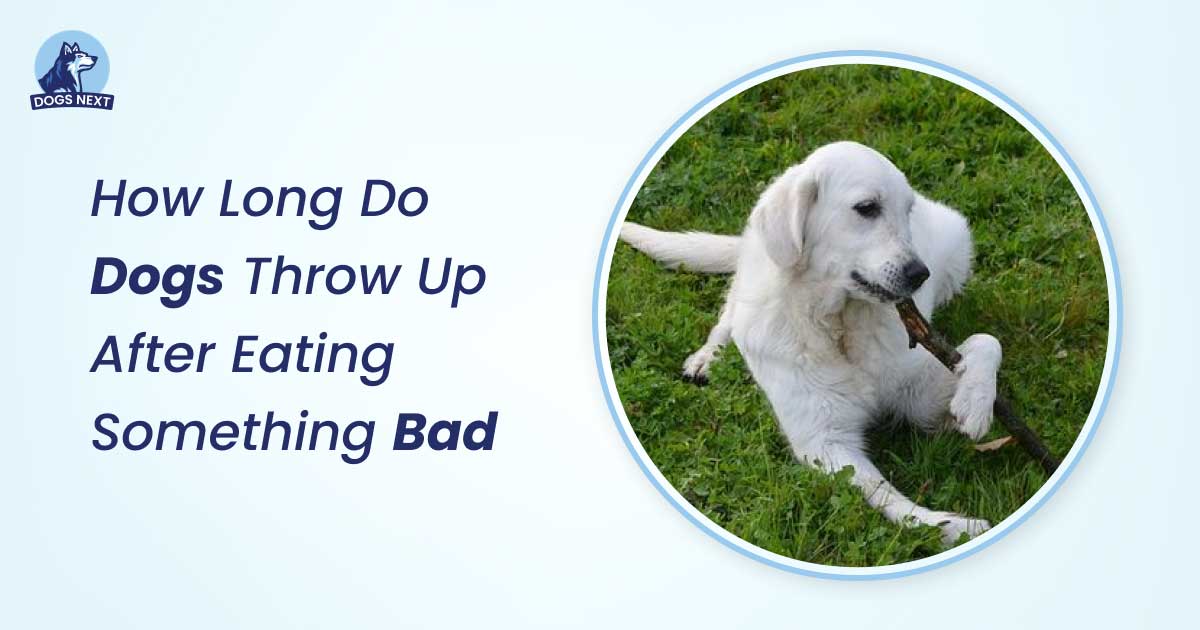Dogs may throw up for up to 24 hours after eating something bad. The duration can vary based on the severity of the ingested substance.
When dogs ingest something harmful, it can lead to vomiting as their body attempts to expel the toxic substance. This reaction is a natural defense mechanism to protect the dog’s health. Understanding how long dogs may continue to vomit after consuming something toxic is crucial for their care and well-being.
Monitoring their symptoms and seeking veterinary assistance if necessary is essential to ensure their recovery. By being aware of the potential duration of vomiting in such situations, pet owners can provide timely and appropriate care for their furry companions.
Common Reasons Dogs Eat Something Bad
As a dog owner, it’s crucial to know how long dogs might throw up after eating something bad. Dogs are curious creatures and often eat things they shouldn’t. Understanding the common reasons dogs eat something bad can help prevent these incidents. Let’s dive into the details.
Types Of Harmful Foods And Objects
Dogs can eat various harmful foods and objects that may cause vomiting. Here are some of the most common:
- Chocolate: Contains theobromine, which is toxic to dogs.
- Grapes and Raisins: Can cause kidney failure.
- Onions and Garlic: Harmful to red blood cells.
- Xylitol: Found in sugar-free gum and candies, can cause liver failure.
- Cooked Bones: Can splinter and cause internal damage.
- Household Items: Includes things like socks, small toys, and batteries.
These foods and objects can be very tempting for dogs. Understanding the risk can help prevent your dog from eating something harmful.
Below is a table summarizing the types of harmful foods and objects and their potential effects:
| Harmful Food/Object | Potential Effect |
| Chocolate | Toxicity due to theobromine |
| Grapes/Raisins | Kidney failure |
| Onions/Garlic | Damage to red blood cells |
| Xylitol | Liver failure |
| Cooked Bones | Internal damage from splinters |
| Household Items | Internal blockages or poisoning |
Typical Symptoms Of Ingesting Harmful Items
Knowing the symptoms of ingesting harmful items can help you act quickly. Common symptoms include:
- Vomiting: Often the first sign.
- Diarrhea: Followed by or accompanied with vomiting.
- Lethargy: Your dog may seem unusually tired.
- Drooling: Excessive drooling is common.
- Loss of Appetite: Your dog may refuse food.
- Abdominal Pain: Your dog may show discomfort when touched.
- Seizures: In severe cases, seizures may occur.
If you notice any of these symptoms, take your dog to the vet immediately. Early intervention can make a significant difference.
Here is a quick reference table for symptoms and what they might indicate:
| Symptom | Possible Indication |
| Vomiting | Ingestion of harmful substances |
| Diarrhea | Gastrointestinal distress |
| Lethargy | Systemic reaction |
| Drooling | Nausea or poisoning |
| Loss of Appetite | Gastrointestinal discomfort |
| Abdominal Pain | Internal injury or blockage |
| Seizures | Severe toxicity |
Recognizing these symptoms early can save your dog’s life.
Initial Signs And Symptoms
Dogs often throw up after eating something bad. Understanding the initial signs and symptoms can help you act quickly. Recognizing these symptoms early can prevent serious health issues. Let’s delve into the initial signs and symptoms of gastrointestinal distress in dogs.
Early Warning Signs Of Gastrointestinal Distress
The early warning signs of gastrointestinal distress in dogs are crucial to identify. Vomiting is the most obvious sign. Your dog might also show signs of nausea such as drooling or licking lips excessively. Loss of appetite can also be an early indicator.
Observe your dog’s behavior closely. Restlessness or discomfort can be signs of gastrointestinal issues. Your dog might also exhibit abdominal pain. Look for signs like whining or avoiding touch.
- Vomiting
- Excessive drooling
- Loss of appetite
- Restlessness
- Abdominal pain
Other signs include bloating and gas. If your dog’s stomach appears swollen or they pass gas more frequently, these could be warning signs. Diarrhea is another common symptom of gastrointestinal distress.
| Symptom | Description |
| Vomiting | Frequent expulsion of stomach contents |
| Excessive drooling | Increased saliva production |
| Loss of appetite | Refusal to eat |
| Restlessness | Inability to stay calm |
| Abdominal pain | Discomfort in the stomach area |
Progression Of Symptoms Over Time
As time progresses, symptoms can worsen. Persistent vomiting is a major concern. Continuous vomiting can lead to dehydration. Signs of dehydration include dry gums, lethargy, and sunken eyes.
Diarrhea can also become more severe. Bloody stools or black, tar-like stools indicate serious issues. This could mean internal bleeding or a severe infection.
- Persistent vomiting
- Dehydration
- Severe diarrhea
- Bloody stools
- Lethargy
Watch for signs of weakness or collapse. These symptoms indicate a critical condition. Immediate veterinary care is necessary. Fever can also develop, signaling an infection or severe inflammation.
| Severe Symptom | Description |
| Persistent vomiting | Continuous expulsion of stomach contents |
| Dehydration | Loss of body fluids |
| Bloody stools | Presence of blood in feces |
| Weakness | Loss of strength |
| Fever | Increased body temperature |
Monitor your dog closely for any changes. Seek veterinary help if symptoms persist or worsen. Early intervention can save your dog’s life.
Duration Of Vomiting
When dogs eat something bad, they often vomit to expel the harmful substance. Understanding the duration of vomiting is crucial for pet owners. It helps in determining the severity of the issue and deciding the next steps. Let’s dive into the typical time frame and factors affecting the duration of vomiting in dogs.
Typical Time Frame For Vomiting After Ingestion
The typical time frame for dogs to start vomiting after eating something bad can vary. Usually, dogs will start vomiting within a few hours. This is the body’s immediate response to eliminate the harmful substance. In some cases, vomiting may occur within 30 minutes, while in others, it might take up to 12 hours.
Here’s a breakdown of the common time frames:
- 30 minutes to 2 hours: If the ingested item is highly toxic, dogs may start vomiting quickly.
- 2 to 6 hours: For mild irritants, vomiting might take a bit longer to commence.
- 6 to 12 hours: If the substance is less harmful, vomiting may be delayed.
The duration of vomiting can also be influenced by the type of ingested item. For instance, food items might cause immediate vomiting, whereas non-food items like small toys might take longer.
| Time Frame | Type of Ingested Item | Severity |
| 30 min – 2 hours | Highly toxic substances | Severe |
| 2 – 6 hours | Mild irritants | Moderate |
| 6 – 12 hours | Non-toxic or less harmful items | Low |
Factors Affecting The Duration
Several factors affect the duration of vomiting in dogs. These factors can make the vomiting last shorter or longer. Here are the main factors:
- Size: Smaller dogs may vomit more quickly due to their faster metabolism.
- Breed: Some breeds have sensitive stomachs and may vomit sooner.
- Type of Ingested Item: Toxic items cause quicker vomiting, while non-toxic items take longer.
For example, a Chihuahua might start vomiting sooner than a Great Dane because of its smaller size. Similarly, breeds like Boxers and Bulldogs, known for sensitive stomachs, may vomit faster.
The type of ingested item plays a significant role. For instance, chocolate, which is toxic to dogs, will cause immediate vomiting. On the other hand, ingesting grass or non-toxic plants may result in delayed vomiting.
Understanding these factors helps in assessing the situation better. It ensures timely action and proper care for the dog.
When To Seek Veterinary Help
Dogs sometimes throw up after eating something bad. This can be worrying for pet owners. Knowing when to seek veterinary help is important. This guide will help you understand the signs that indicate it’s time to call the vet.
Prolonged Or Severe Vomiting
Vomiting that lasts more than a day is a concern. Prolonged vomiting can lead to serious health problems. If your dog continues to vomit for more than 24 hours, contact your vet immediately.
Severe vomiting is another red flag. If your dog vomits multiple times in an hour, it could be a sign of a serious problem. Pay attention to the following:
- Vomiting more than twice in an hour
- Vomiting with blood
- Vomiting with foam or bile
A dog that vomits severely may have ingested something toxic. Quick action is needed in such cases to prevent further complications.
Additional Symptoms
Watch for additional symptoms that accompany vomiting. These symptoms can help determine the severity of your dog’s condition. Common additional symptoms include:
- Lethargy: A lethargic dog will show little energy or interest in activities.
- Diarrhea: Diarrhea along with vomiting can lead to dehydration quickly.
- Abdominal pain: Dogs may whine or show discomfort when their abdomen is touched.
- Loss of appetite: Refusing to eat can indicate a serious issue.
- Fever: Elevated body temperature can signal an infection or other health problem.
If your dog shows any of these symptoms, it’s best to seek veterinary help promptly.
Dehydration And Electrolyte Imbalance
Dehydration is a critical concern for vomiting dogs. Dehydration occurs when your dog’s body loses more fluids than it takes in. This can happen quickly with vomiting and diarrhea.
Signs of dehydration include:
- Dry gums
- Sunken eyes
- Loss of skin elasticity
Electrolyte imbalance is another danger. Vomiting can cause a loss of essential minerals like sodium, potassium, and chloride. These minerals are vital for normal body functions.
To check for dehydration, gently pinch the skin on your dog’s neck. If it doesn’t return to normal quickly, your dog may be dehydrated. Another test is to check the gums. Dry or tacky gums are a sign of dehydration.
If you suspect dehydration or an electrolyte imbalance, contact your vet immediately. They may recommend fluids and electrolytes to restore your dog’s balance.
At-home Care
When dogs eat something bad, they often throw up. It can be worrying for pet owners. Understanding how long this lasts and providing proper at-home care can help. Follow these steps to ensure your dog recovers quickly and stays healthy.
Keeping The Dog Hydrated
Hydration is crucial for dogs after vomiting. Vomiting causes loss of fluids, leading to dehydration. Offer small amounts of water frequently.
- Provide clean, fresh water every few hours.
- Use a syringe to offer water if the dog refuses to drink.
- Electrolyte solutions designed for pets can also help. They replenish lost minerals.
Signs of dehydration include:
| Signs | Description |
| Dry gums | Gums feel sticky or dry to touch. |
| Sunken eyes | Eyes appear sunken or dull. |
| Lethargy | Dog appears tired and less active. |
| Loss of skin elasticity | Skin does not return to normal shape quickly when pinched. |
If you notice these signs, contact your vet immediately. Keeping your dog hydrated helps speed up recovery and prevents further complications.
Offering Bland Diet Once Vomiting Subsides
Once vomiting subsides, introduce a bland diet. This helps the digestive system recover without causing more irritation.
Start with small portions. Gradually increase the amount if the dog keeps the food down. A bland diet includes:
- Boiled chicken with no skin or bones.
- White rice cooked plain.
- Boiled potatoes, mashed without butter or seasoning.
Feed this diet for a few days. Gradually reintroduce the regular diet over a week. Monitor your dog for any signs of discomfort.
Here’s a simple feeding schedule:
| Day | Food | Portion |
| Day 1-2 | Bland diet | Small portions |
| Day 3-4 | Bland diet | Moderate portions |
| Day 5-7 | Mix of bland diet and regular food | Gradually increasing |
This approach ensures the digestive system adjusts slowly, reducing the risk of further vomiting.
Monitoring For Continued Symptoms
Observe your dog for continued symptoms. Persistent vomiting, diarrhea, or lethargy could indicate a more serious issue.
Signs to watch for include:
- Frequent vomiting beyond 24 hours.
- Blood in vomit or stool.
- Severe lethargy or weakness.
- Loss of appetite for more than a day.
- Abdominal pain or bloating.
If you notice these symptoms, seek veterinary care. Provide your vet with details about the vomiting episode. This includes what your dog ate and how long the vomiting lasted.
Early intervention can prevent complications. It ensures your dog gets the necessary treatment promptly.
Keep a diary of your dog’s symptoms. Note any changes in behavior or appetite. This information helps the vet diagnose and treat your dog effectively.
Preventative Measures
When dogs eat something bad, they often throw up to expel the harmful substance. This can last a few hours to a day. Preventative measures can help avoid these situations and keep your furry friend safe. Let’s explore some key strategies.
Safe Feeding Practices
Ensuring your dog’s diet is safe is crucial. Follow these tips:
- Feed high-quality dog food: Choose reputable brands with natural ingredients.
- Avoid table scraps: Human food can upset your dog’s stomach.
- Consistent feeding times: Maintain a schedule to help digestion.
- Fresh water: Ensure your dog always has access to clean water.
It’s also essential to be aware of toxic foods. Common harmful items include:
| Toxic Food | Harmful Effects |
| Chocolate | Vomiting, diarrhea, seizures |
| Grapes and Raisins | Kidney failure |
| Onions and Garlic | Damage to red blood cells |
Dog-proofing The Home
Make your home safe for your dog by removing hazards. Take these steps:
- Secure trash cans: Dogs can rummage through garbage and ingest harmful items.
- Store chemicals safely: Keep cleaning products and medications out of reach.
- Child-proof cabinets: Use locks to prevent access to dangerous substances.
- Remove small objects: Dogs can swallow toys, coins, and other small items.
Use barriers to restrict access to certain areas:
- Install baby gates to block off rooms with hazards.
- Use closed doors to keep dogs out of the kitchen.
Regularly inspect your home for potential dangers:
- Check for dropped pills or small objects on the floor.
- Ensure plants are non-toxic to dogs.
Training To Avoid Harmful Items
Training your dog can prevent them from eating harmful items. Teach these commands:
- Leave it: This command stops your dog from picking up an item.
- Drop it: Use this to make your dog release something from their mouth.
Positive reinforcement works best for training:
- Reward your dog with treats or praise when they obey commands.
- Practice regularly to reinforce the behavior.
Interactive toys can keep your dog occupied and less likely to eat harmful items:
- Use puzzle toys to engage their mind.
- Provide chew toys to satisfy their natural chewing instinct.
Enroll your dog in obedience classes for professional guidance. Socialization with other dogs can also teach appropriate behavior.
Frequently Asked Questions
How Long After Eating Something Bad Will A Dog Get Sick?
A dog might show signs of illness within 2 to 4 hours after eating something bad. Symptoms can vary based on the type and amount consumed. Watch for vomiting, diarrhea, or lethargy and contact a vet if symptoms occur.
How Long After A Dog Eats Something Can You Make Them Throw Up?
You can make a dog throw up within 1-2 hours after eating something harmful.
When Should You Be Concerned About A Dog Throwing Up?
If your dog vomits persistently, shows lethargy, or has blood in vomit, consult a vet immediately.
What To Do When A Dog Is Throwing Up After Eating But Acting Normal?
Monitor your dog closely. Offer small, bland meals like boiled chicken and rice. Ensure hydration. If vomiting persists, consult a vet.
Conclusion
Dog vomiting duration varies based on what they consumed. Always monitor your pet closely after such incidents. Consult a vet if symptoms persist. Timely intervention ensures your dog’s health and safety. Keeping harmful items out of reach can prevent future issues.
Your quick response helps maintain your furry friend’s well-being.

I’m David, an expert contributor and writer, with two furry friends of my own, I know the challenges of raising and caring for dogs. From training to nutrition and health, my goal is to provide valuable insights and advice to help create strong bonds and happy, healthy lives. Find me in Twitter.




